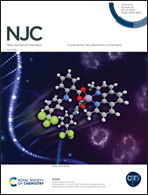A composite polyvinyl alcohol–medicinal plant extract crosslinked hydrogel: a novel soft system with excellent rhodamine B adsorption and significant antifungal activity
Abstract
Rhodamine B (RhB), a xanthene dye, has been tagged as a notorious environmental pollutant because it is very harmful to humans as well as to aquatic life, and needs to be removed from the environment. Hydrogels composed of hydrophilic polymers have been used widely to remove such pollutants. Herein we report an affordable, simple, and environmentally friendly synthesis of polyvinyl alcohol hydrogels crosslinked by different amounts of extract from Bergenia stracheyi, a medicinal plant. This plant is rich in specialised metabolites such as polyphenols, flavonoids, and tannins, which play a major role in the formation of hydrogels through extensive hydrogen bonding between the hydroxyl groups present in these secondary metabolites and the hydroxyl groups of the polyvinyl alcohol (PVA) polymer. The synthesised hydrogels were characterised using rheology, scanning electron microscopy (SEM) and Fourier-transform infrared (FTIR) spectroscopy. The rheological studies reveal that the as-prepared hydrogels possess good mechanical strength with storage modulus (G′) values in the range from 3067 to 10 011 Pa and a significant self-recovery percentage ranging from 59 to 100%. Temperature sweep experiments revealed that the hydrogels are stable up to the temperature of 50 °C, and above this temperature, a gel-to-sol transition is observed, except for the hydrogel PBSE10. The hydrogels were tested for the adsorption of RhB dye from the aqueous medium. It was found that the adsorption process follows pseudo-second-order kinetics and is in good agreement with the Langmuir model, possessing a very high adsorption capacity with a maximum adsorption capacity value of 3816.8 mg g−1 which is an outstanding achievement for the removal of RhB dye. Furthermore, the recyclability of the RhB-adsorbed hydrogel was attained using sodium dodecyl sulphate (SDS) solution as the eluting agent, and the removal efficiency was almost the same after five cycles of the adsorption–desorption process. The hydrogels also demonstrated good biocompatibility, as confirmed via MTT assay on human embryonic kidney (HEK) cells, with potential antifungal activity against Candida albicans.



 Please wait while we load your content...
Please wait while we load your content...